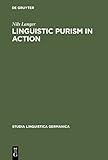Linguistic Purism in Action : How auxiliary tun was stigmatized in Early New High German / Nils Langer.
Material type: TextSeries: Studia Linguistica Germanica ; 60Publisher: Berlin ; Boston : De Gruyter, [2013]Copyright date: ©2001Edition: Reprint 2013Description: 1 online resource (312 p.) : Zahlr. AbbContent type:
TextSeries: Studia Linguistica Germanica ; 60Publisher: Berlin ; Boston : De Gruyter, [2013]Copyright date: ©2001Edition: Reprint 2013Description: 1 online resource (312 p.) : Zahlr. AbbContent type: - 9783110170245
- 9783110881103
- 437/.02
- PF4521
- online - DeGruyter
- Issued also in print.
| Item type | Current library | Call number | URL | Status | Notes | Barcode | |
|---|---|---|---|---|---|---|---|
 eBook
eBook
|
Biblioteca "Angelicum" Pont. Univ. S.Tommaso d'Aquino Nuvola online | online - DeGruyter (Browse shelf(Opens below)) | Online access | Not for loan (Accesso limitato) | Accesso per gli utenti autorizzati / Access for authorized users | (dgr)9783110881103 |
Frontmatter -- Table of Content -- Acknowledgements -- Abbreviations -- 1. Introduction -- 2. Part I. The Distribution of Auxiliary Tun -- 3. Part II. The Stigmatization of Auxiliary Tun -- 4. Conclusion -- 5. Appendix: Data and Bibliographies
restricted access online access with authorization star
http://purl.org/coar/access_right/c_16ec
Anhand der Geschichte des Hilfsverbs tun (Susanne tut gern Kuchen essen) seit 1350 wird gezeigt, dass präskriptive Grammatiker im 16. und 17. Jahrhundert aktiv in den Standardisierungesprozess eingegriffen haben, um gewisse morphosyntaktische Konstruktionen von der Prestigesprache "Standarddeutsch" fernzuhalten.
The auxiliary do (tun) is one of the most-discussed constructions in West Germanic. In German, there is a striking opposition between modern standard German, where the construction is virtually ungrammatical and considered to be "sub-standard" by most speakers, whilst, as this book shows, the construction is attested in all modern dialects as well as historic stages since 1350. In answering why auxiliary tun is ungrammatical in modern standard German, it is shown that the stigmatization of tun was caused by prescriptive grammarians in the 16th-18th century. Furthermore it is shown that the stigmatization of tun as "bad" German occurred in clearly discernible stages, from bad poetry (1550-1680), to bad written German (1680-1740) and finally to "bad" German in general (after 1740), thus providing evidence that the history of the standardization of German needs to take into account direct metalinguistic comments from prescriptive grammarians. The effectiveness of linguistic purism is also shown by evidence from two other constructions, namely polynegation and double perfect.
Issued also in print.
Mode of access: Internet via World Wide Web.
In English.
Description based on online resource; title from PDF title page (publisher's Web site, viewed 28. Feb 2023)


